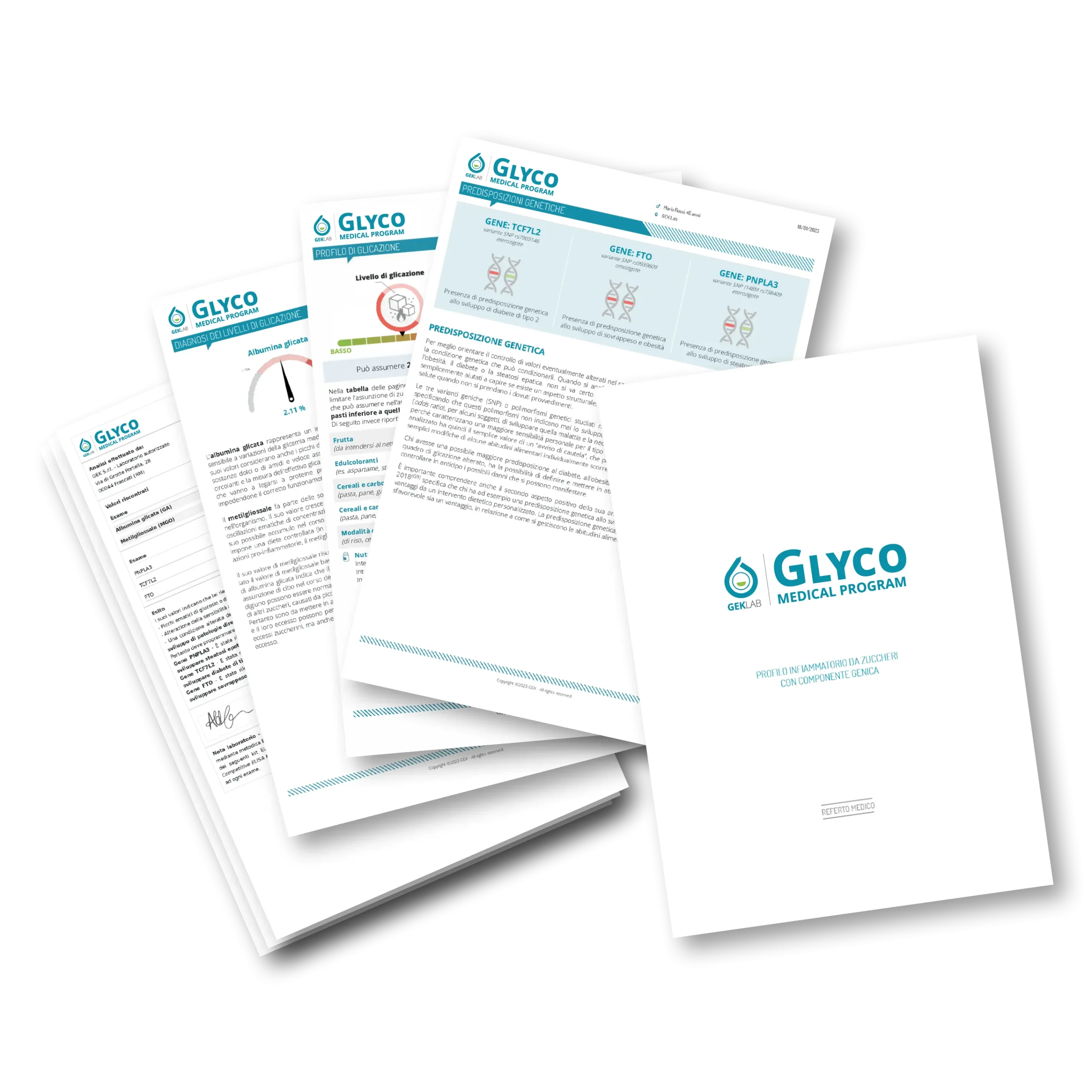
The Glyco Medical Program analyzes the percentage of glycated albumin (GA) and the levels of methylglyoxal (MGO) present in the body, two absolutely unconventional, innovative, and scientifically impactful analytes, currently measured in very few top-tier laboratories, which we are making easily accessible to the population through a simple and quick sampling method.
Through the Glyco Medical Program, some genetic variants related to metabolism are also analyzed, indicating a possible predisposition to conditions such as diabetes, obesity, and hepatic steatosis.
The measurement of these two indicators provides precise information about the individual’s inflammatory condition related to sugars and the dietary relationship with all sugars, including “hidden” ones, such as fructose and other molecules metabolized in a similar way, such as alcohol and polyols.
Through the Glyco Medical Program, it is possible to easily and effectively capture your relationship with sugars and correct it if excesses or situations arise that require a rebalancing.
These are indications that unfortunately cannot be assessed by fasting blood sugar and glycated hemoglobin, as confirmed since 2019 by the most important international diabetes journals.
In the presence of altered levels of glycated albumin and methylglyoxal, which identify blood spikes of glucose, fructose, alcohol, and polyols, it is important to correctly identify the possible dietary causes and immediately implement the specific nutritional interventions.
The main cause of this alteration is always determined by the individually excessive consumption of simple sugars, alcohol, sweeteners, refined carbohydrates, sugary sodas, fruit, and jams or marmalades, even those “sugar-free.”
In many cases, the presence of these values is due to the relative imbalance between proteins, carbohydrates, and fibers within a single meal or snack.
Moderate and careful individuals, who ensure they do not eat or introduce simple sugars but who, at lunch, eat brown rice with vegetables and a small amount of protein, with some added fruit (apparently a healthy meal), may find themselves individually developing high blood sugar levels and sugar spikes due to the disproportion between the complex carbohydrates (too many, although very healthy) and the protein (too little) in that single meal.”
The Glyco Medical Program provides the opportunity to assess “sugar damage” well before diabetes appears, even in seemingly normal conditions.
Through this product, it is possible to “capture” in a simple and effective way the individual situation and the relationship with sugars.
The Glyco Medical Program offers significant personalization. In fact, based on genetic data and the highlighted levels of MGO and GA, it provides at least 84 different types of profiles and applicable nutritional and nutraceutical solutions. Each of these, within a medical context, can be further tailored to the individual case.
Below, we can summarize again the intervention possibilities that can be immediately implemented to modulate these values:
- Follow a diet that includes the use of carbohydrates with a low glycemic index, always correctly balanced with an adequate intake of healthy fats and proteins (respecting individual needs and corresponding to at least 0.83 g per kg of body weight), in line with the Harvard Medical School’s “healthy plate” guidelines.
- Ensure a rich and balanced breakfast, as it is scientifically proven that this meal influences glucose levels. For example, whole-grain bread with scrambled eggs and avocado or Greek yogurt with oatmeal, nuts, and a soft-boiled egg. Additionally, the consumption of snacks such as fruit, fruit juices, jam, fruit yogurt, or crackers leads to the formation of pro-inflammatory spikes, and snacking between meals is a typical dietary habit to avoid. For glucose control, it is more beneficial to stick to just three meals a day.
- Consistently maintain a good level of physical activity for effective control of blood glucose levels and body weight
- Allow yourself occasional indulgence in sweets or alcohol, respecting the guidelines provided in the glycation table included in the report.
- Always evaluate with a trusted nutritionist and/or pharmacist the need for supplements that can help improve carbohydrate metabolism, as identified in the “suggested nutraceuticals” section of the table.
- In consultation with your nutritionist, techniques such as short-term fasting or intermittent fasting could also be effective strategies to bring your body back into balance.
It is also scientifically proven that individuals with a “relatively” unfavorable genetic predisposition towards obesity, diabetes, and hepatic steatosis should not consider this as an “inevitable fate.” Many studies have shown that people who are more “genetically susceptible” to obesity and steatosis are also the most responsive to nutritional changes and can achieve positive results in terms of weight variations.
L’impegno quindi, in questi casi, può dare risultati anche più rapidi.
Edited by The scientific Editorial Board GEKLab





